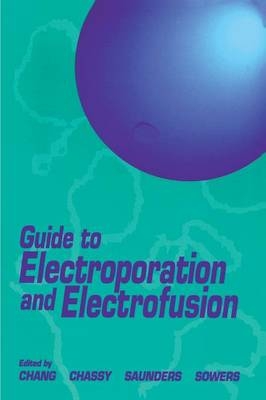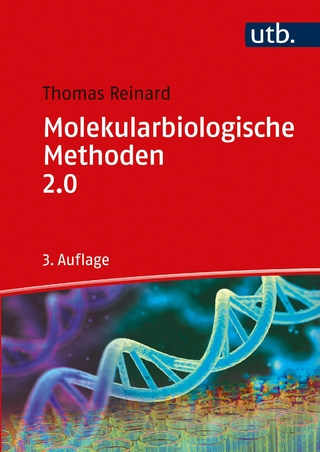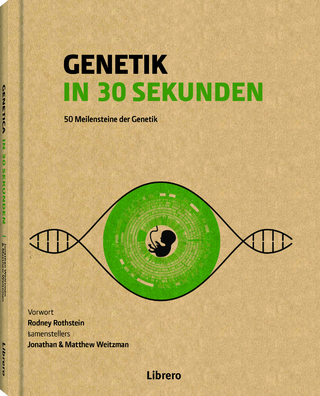
Guide to Electroporation and Electrofusion
Academic Press Inc (Verlag)
978-0-12-168041-1 (ISBN)
- Titel ist leider vergriffen;
keine Neuauflage - Artikel merken
Electroporation is an efficient method to introduce macromolecules such as DNA into a wide variety of cells. Electrofusion results in the fusion of cells and can be used to produce genetic hybrids or hybridoma cells.Guide to Electroporation and Electrofusion is designed to serve the needs of students, experienced researchers, and newcomers to the field. It is a comprehensive manual that presents, in one source, up-to-date, easy-to-follow protocols necessary for efficient electroporation and electrofusion of bacteria, yeast, and plant and animal cells, as well as background information to help users optimize their results through comprehension of the principles behind these techniques.
D.C. Chang, B.M. Chassy, J.A. Saunders, and A.E. Sowers, Overview of Electroporation and Electrofusion.
Mechanisms and Fundamental Processes in Electroporation and Electrofusion:
D.C. Chang, Structure and Dynamics of Electric Field-Induced Membrane Pores as Revealed by Rapid-Freezing Electron Microscopy.
K. Kinosita, M. Hibino, H. Itoh, M. Shigemori, K. Hirano, Y. Kirino, and T. Hayakawa, Events of Membrane Electroporation Visualized on a Time Scale from Microseconds to Seconds.
T.Y. Tsong, Time Sequence of Molecular Events in Electroporation.
L.V. Chernomordik, Electropores in Lipid Bilayers and Cell Membranes.
E. Neumann, A. Sprafke, E. Boldt, and H. Wolf,
Biophysical Considerations of Membrane Electroporation.
J.C. Weaver and A. Barnett, Progress Toward a Theoretical Model for Electroporation Mechanism: Membrane Electrical Behavior and Molecular Transport.
A.E. Sowers, Mechanisms of Electroporation and Electrofusion.
J. Teissi*aae and M.-P. Rols, Interfacial Membrane Alteration Associated with Electropermeabilization and Electrofusion.
D.S. Dimitrov, Membrane Fusion Kinetics.
S.W. Hui and D.A. Stenger, Effects of Intercellular Forces on Electrofusion.
Q. Zheng and D.C. Chang, Dynamics of Cytoskeletal Reorganization in CV-1 Cells during Electrofusion.
Applications of Electroporation and Electrofusion in Current Research:
H. Potter and S.W.F. Cooke, Gene Transfer into Adherent Cells Growing on Microbeads.
L.H. Reid and O. Smithies, Gene Targeting and Electroporation.
J.A. Saunders, B.F. Matthews, and S.L. Van Wert, Pollen Electrotransformation for Gene Transfer in Plants.
G.W. Bates, Electrofusion of Plant Protoplasts and the Production of Somatic Hybrids.
J.T. Trevors, B.M. Chassy, W.J. Dower, and H.P. Blaschek, Electrotransformation of Bacteria by Plasmid DNA.
W.J. Dower and S.E. Cwirla, Creating Vast Peptide Expression Libraries: Electroporation as a Tool to Construct Plasmid Libraries of Greater Than 109 Recombinants.
D.C. Chang, J.R. Hunt, Q. Zheng, and P.-Q. Gao, Electroporation and Electrofusion Using a Pulsed Radio-Frequency Electric Field.
Y. Mouneimme, P.-F. Tosi, R. Barhoumi, and C. Nicolau, Electroinsertion: An Electrical Method for Protein Implantation into Cell Membranes.
R.R. Swezey and D. Epel, Electroporation as a Tool to Study Enzyme Activities in Situ.
U. Karsten, P. Stolley, and B. Seidel, Comparison of PEG-Induced and Electric Field-Mediated Cell Fusion in the Generation of Monoclonal Antibodies against a Variety of Soluble and Cellular Antigens.
L.C. Smith, Production of Genetically Identical Embryos by Electrofusion.
R. Heller and R. Gilbert, Development of Cell-Tissue Electrofusion for Biological Applications.
S.R. Gallagher and D.C. Chang, Novel Applications of Electroporation.
Practical Protocols for Electroporation and Electrofusion:
D.C. Chang, Design of Protocols for Electroporation and Electrofusion: Selection of Electrical Parameters.
H. Potter, Protocols for Using Electroporation to Stably or Transiently Transfect Mammalian Cells.
G.R. MacGregor, Optimization of Electroporation Using Reporter Genes.
J.A. Saunders and G.W. Bates, Genetic Manipulation of Plant Cells by Means of Electroporation and Electrofusion.
W.J. Dower, B.M. Chassy, J.T. Trevors, and H.P. Blaschek, Protocols for the Transformation of Bacteria by Electroporation.
D.M. Becker and L. Guarente, Protocol for High-Efficiency Yeast Transformation.
M.I. Mally, M.E. McKnight, and M.C. Glassy, Protocols of Electroporation and Electrofusion for Producing Human Hybridomas.
S.M.M. Rehman, S. Perkins, U. Zimmermann, and S.K.H. Foung, Human Hybridoma Formation by Hypo-Osmolar Electrofusion.
J.M. Robl, P. Collas, R. Fissore, and J.R. Dobrinsky, Electrically Induced Fusion and Activation in Nuclear Transplant Embryos.
Instrumentation for Electroporation and Electrofusion:
B.M. Chassy, J.A. Saunders, and A.E. Sowers, Pulse Generators for Electrofusion and Electroporation.
Chapter References.
Index.
| Erscheint lt. Verlag | 3.2.1992 |
|---|---|
| Verlagsort | San Diego |
| Sprache | englisch |
| Maße | 152 x 229 mm |
| Gewicht | 790 g |
| Themenwelt | Naturwissenschaften ► Biologie ► Genetik / Molekularbiologie |
| Naturwissenschaften ► Biologie ► Zellbiologie | |
| ISBN-10 | 0-12-168041-X / 012168041X |
| ISBN-13 | 978-0-12-168041-1 / 9780121680411 |
| Zustand | Neuware |
| Haben Sie eine Frage zum Produkt? |
aus dem Bereich


